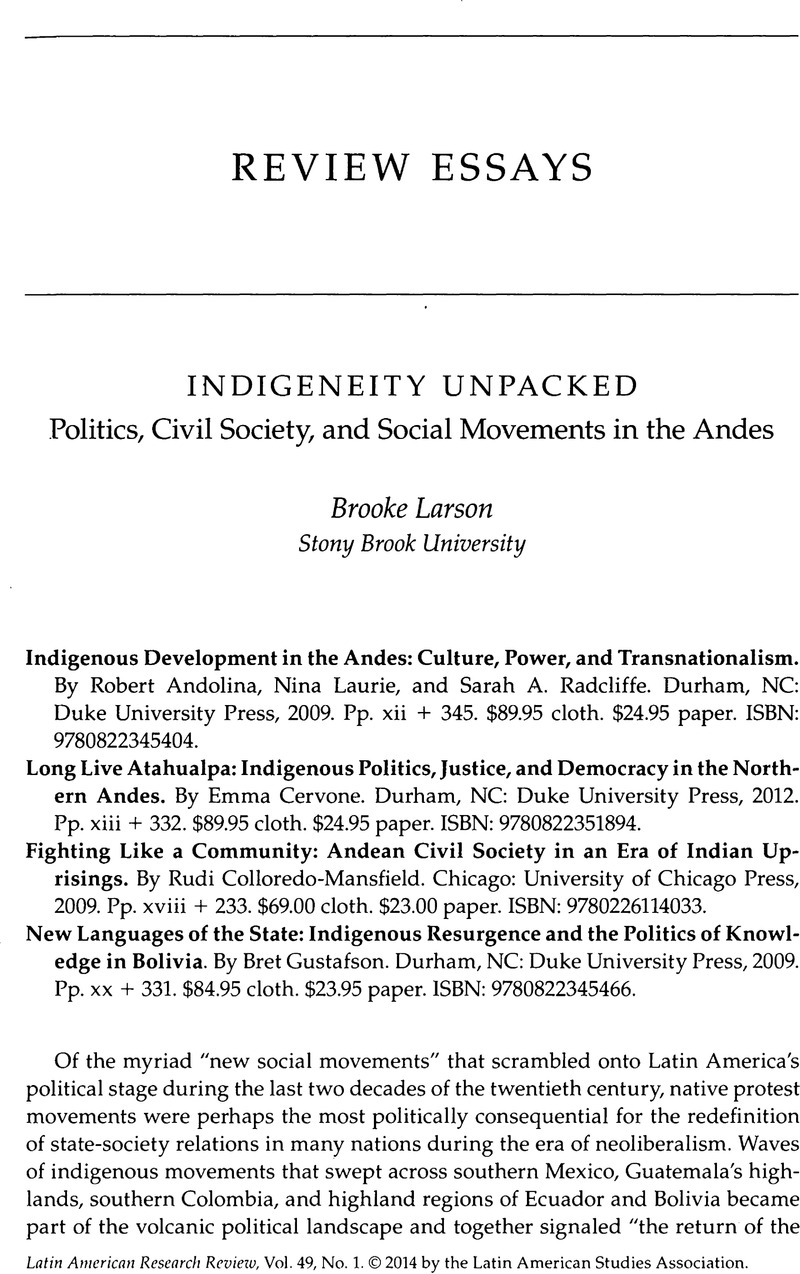Published online by Cambridge University Press: 05 September 2022

1. Xavier Albó, “Andean People in the Twentieth Century,” in The Cambridge History of the Native Peoples of the Americas, ed. Frank Salomon and Stuart Schwartz (Cambridge: Cambridge University Press, 1999), 3:2, 823.
2. See, for example, Arturo Escobar and Sonia E. Alvarez, eds., The Making of Social Movements in Latin America: Identity, Strategy, and Democracy (Boulder, CO: Westview Press, 1992); Sonia E. Alvarez, Evelina Dagnino, and Arturo Escobar, eds., Cultures of Politics, Politics of Cultures: Re-Visioning Latin American Social Movements (Boulder, CO: Westview Press, 1998); and Kay B. Warren and Jean E. Jackson, eds., Indigenous Movements, Self-Representation, and the State in Latin America (Austin: University of Texas Press, 2002).
3. For a small sample of scholarly comparison and debate on the “Peru anomaly,” see Orin Starn, “‘I Dreamed of Foxes and Hawks’: Reflections on Peasant Protest, New Social Movements, and the Rondas Campesinas of Northern Peru,” in The Making of Social Movements in Latin America, ed. Arturo Escobar and Sonia E. Alvarez, 89–111; Deborah J. Yashar, Contesting Citizenship in Latin America: The Rise of Indigenous Movements and the Postliberal Challenge (Cambridge: Cambridge University Press, 2005); and Lisa M. Glidden, Mobilizing Ethnic Identity in the Andes: A Study of Ecuador and Peru (Lanham, MD: Lexington Books, 2011).
4. Sample volumes, in addition to the work cited above, include Alison Brysk, From Tribal Village to Global Village: Indian Rights and International Relations in Latin America (Stanford, CA: Stanford University Press, 2000); Rachel Sieder, ed., Multiculturalism in Latin America: Indigenous Rights, Diversity, and Democracy (London: Palgrave Macmillan, 2002); David Maybury-Lewis, ed., The Politics of Ethnicity: Indigenous Peoples in Latin America States (Cambridge, MA: David Rockefeller Center for Latin American Studies, Harvard University, 2002); Erick D. Langer with Elena Muñoz, eds., Contemporary Indigenous Movements in Latin America (Wilmington, DE: Scholarly Resources, 2003); and Nancy Grey Postero and Leon Zamosc, eds., The Struggle for Indigenous Rights in Latin America (Brighton, England: Sussex Academic Press, 2004).
5. José Antonio Lucero, Struggles of Voice: The Politics of Indigenous Representation in the Andes (Pittsburgh, PA: Pittsburgh University Press, 2008), 12.
6. The 1990 uprising was sparked by the occupation of a church in downtown Quito by CONAIE leaders and other activists. Their action eventually escalated into a series of massive street demonstrations, road blockades that essentially shut down the government, and peasant land occupations. Although land issues defined the movement's early agenda, the uprising marked the consolidation of a national Indian movement and the insertion of ethnic rights into the center of national discourses and constitutional reforms (most dramatically, the legal redefinition of Ecuador as a multicultural nation).
7. This book fits into a larger body of historical and anthropological literature that departs from the premise that Andean rural society, and indigenous communities in particular, were fraught with internal conflicts militating against the organicity of a unitary political consciousness (class, ethnic, or otherwise). Andean studies offer a wealth of approaches to and case studies of Andean peasant politics—scaling up from the quotidian locus of resistance to the millenarian moment of mass upheaval. Random examples spring to mind: Gavin Smith's Livelihood and Resistance: Peasants and the Politics of Land in Peru (Berkeley: University of California Press, 1989), which shows that grassroots mobilizations were powered by communal traditions of dissension and democracy; Florencia E. Mallon's Peasant and Nation: The Making of Postcolonial Mexico and Peru (Berkeley: University of California Press, 1995), theorizing and documenting “the conflictual construction of community” in the cases of nineteenth-century highland Peru and Mexico; and Joanne Rappaport's Intercultural Utopias: Public Intellectuals, Cultural Experimentation, and Ethnic Pluralism in Colombia (Durham, NC: Duke University Press, 2005), which advances what she calls a “pluralist approach to ethnic politics” for Colombia's Cauca region. Following different disciplinary priorities, all these books have sought to understand how rural peoples have struggled “to regain the solidarity, cohesion, and mutuality of their communal traditions” in the face of corrosive market and state forces (Mallon, Peasant and Nation, 64).
8. Marisol de la Cadena, “‘Women Are More Indian’: Ethnicity and Gender in a Community near Cuzco,” in Ethnicity, Markets, and Migration in the Andes: At the Crossroads of History and Anthropology, ed. Brooke Larson and Olivia Harris, with Enrique Tandeter (Durham, NC: Duke University Press, 1995), 329–348.
9. James C. Scott, Seeing Like a State: How Certain Schemes to Improve the Human Condition Have Failed (New Haven: Yale University Press, 1998).
10. This book keeps company with a growing subfield of study that relates indigenous movements not only to international agencies promoting Indian rights but also to the vast multinational world of development policy and discourse. For sample work, see David Gow, Countering Development: Indigenous Modernity and the Moral Imagination (Durham, NC Duke University Press, 2008); Rappaport, Intercultural Utopias; and Kevin Healy, Llamas, Weavings, and Organic Chocolate: Multicultural Grassroots Development in the Andes and Amazon of Bolivia (Notre Dame, IN: University of Notre Dame Press, 2001).
11. The Movimiento Nacional Revolucionario (MNR) governed the country between 1952 and 1964. It launched a series of social reforms (including land reform, universal suffrage, public education reforms, and the nationalization of the largest tin mines) and promoted the idea of Indian assimilation into Bolivia's mestizo national culture.
12. María Elena García, Making Indigenous Citizens: Identities, Education, and Multicultural Development in Peru (Stanford, CA: Stanford University Press, 2005).
13. See for example Nancy Grey Postero, “Now We Are Citizens”: Indigenous Politics in Postmulticultural Bolivia (Stanford, CA: Stanford University Press, 2007); and Nicole Fabricant, Mobilizing Bolivia's Displaced: Indigenous Politics and the Struggle over Land (Chapel Hill: University of North Carolina Press, 2012).
14. Charles Hale, “Does Multiculturalism Menace? Governance, Cultural Rights and the Politics of Identity in Guatemala,” Journal of Latin American Studies 34 (2002): 485, 491.
15. Ibid., 493.